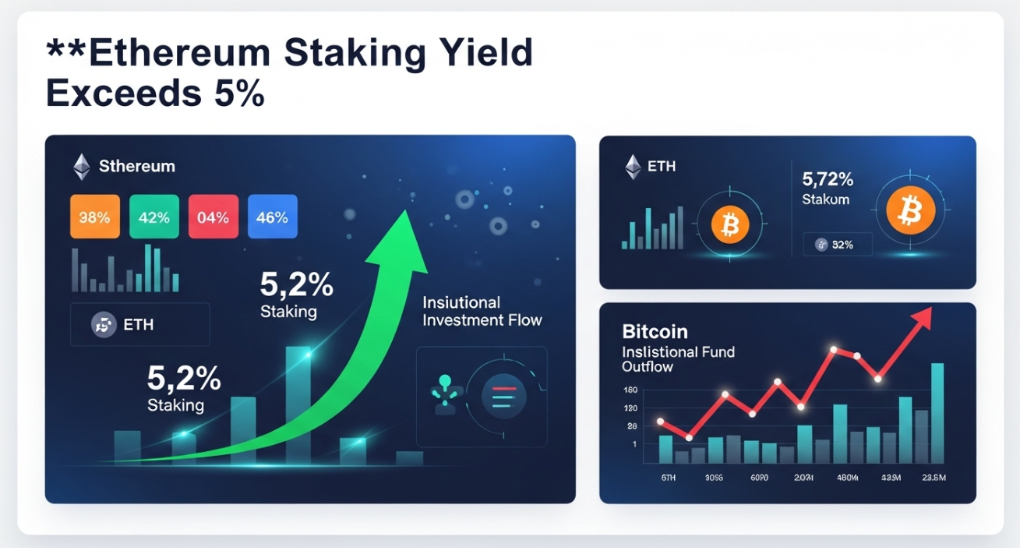As Bitcoin holders still anticipate price increases from the halving cycle, smart money has already shifted towards crypto assets that can generate actual cash flow—this silent revolution is reshaping the entire market's valuation logic.
Data on capital flows for the third quarter of 2025 reveals a disruptive trend: Ethereum ETFs attracted $3.9 billion in a single month, while Bitcoin ETFs experienced a net outflow of $751 million during the same period.
Behind this capital migration is the institutions' urgent pursuit of yield—Ethereum staking offers a stable return of 4.5%-5.2%, while Bitcoin yields zero. Even more astonishing is the surge in the market capitalization of stablecoins, which skyrocketed to $287.6 billion, providing an unprecedented liquidity foundation for the entire ecosystem.

01 Market Size Exceeds $4 Trillion, Stablecoins Become Invisible Pillars
The cryptocurrency market achieved milestone growth in the third quarter of 2025, with several key indicators reaching all-time highs. Here are the specific data performances:
Table 1: Key Indicators of the Crypto Market in Q3 2025
| Indicator | Value | Change | |------------------------|----------------|----------------| | Total Crypto Market Cap | $4.0 trillion | 16.4% increase | | Daily Trading Volume | $155 billion | Reversed decline from previous two quarters | | Total Stablecoin Market Cap | $287.6 billion | 18.3% increase | | USDe Market Cap | Increased by $9.4 billion | Surged 177.8% | | Fear and Greed Index | 28 points | Entered "Fear" zone |
Source: Compiled by AiCoin
● This figure surpasses the record set during the 2021 bull market, marking a full market recovery. More noteworthy is the increase in market activity. The average daily trading volume surged to $155 billion, completely reversing the decline trend of the previous two quarters. The improvement in market depth and liquidity has provided the necessary conditions for large-scale institutional capital entry.
● Stablecoins played a key role in this growth. The total market cap of stablecoins soared by 18.3% to $287.6 billion, setting a new historical high. Among them, USDe performed particularly well, with its market cap skyrocketing by 177.8%, surpassing USDS to become the third-largest stablecoin.
● "Stablecoins are no longer just simple trading mediums; they have become the liquidity cornerstone of the entire DeFi ecosystem," noted crypto analyst Zhang Lin. "The $287.6 billion market cap of stablecoins means that the crypto market has a solid internal currency foundation, significantly reducing trading friction and cross-chain settlement costs. Now, investors can seamlessly transfer value across different chains and protocols, which was unimaginable a few years ago."
02 Public Chain Performance Competition Heats Up, Ethereum and BNB Lead the Market
Mainstream public chains demonstrated strong development momentum this quarter, particularly Ethereum and BNB Chain, which made significant progress in technical upgrades and ecosystem development. Performance improvements and practical applications have become new standards for measuring public chain value.
● Ethereum's price skyrocketed from $2,502 to $4,956, reaching an all-time high with a quarterly increase of 68.5%. This performance significantly outpaced major competitors like Bitcoin, Solana, and XRP. More importantly, Ethereum's average daily trading volume surged from $19.5 billion in the second quarter to $33.4 billion, an increase of over 70%.

Ethereum's outstanding performance is attributed to its continuous technological iteration. Following the successful completion of the Fusaka upgrade, Ethereum has initiated the closure process for the Holešky testnet and is smoothly transitioning the developer ecosystem to the Hoodi and Sepolia testnets. These technological improvements lay the groundwork for the upcoming Verge upgrade, which promises to reduce node storage requirements by 90%.
● BNB also performed impressively, closing the third quarter at $1,030, a 57.3% increase. Entering the fourth quarter, its price continued to climb to a new high of $1,375. In terms of trading activity, BNB's average daily trading volume doubled from $800 million in the second quarter to $1.7 billion.

Key factors driving the rise of BNB include the launch of the new perpetual contract DEX "Aster" with BNB trading pairs, and PancakeSwap's deep integration through the Binance Alpha program. These developments have significantly activated DeFi activities on the BNB Chain, enhancing BNB's utility value.
● The DeFi sector as a whole is showing a strong recovery trend. The total value locked (TVL) in DeFi rose from $115 billion to $161 billion in Q3 2025, an increase of 40.2%. Emerging projects like Avantis (AVNT) and Aster (ASTER) have strongly contributed to the overall rebound of the DeFi sector, with its market share increasing from 3.3% in Q2 to 4.0%.
03 Yield Revolution: The Logic Behind Institutional Capital Reallocation
Data on capital flows in October 2025 clearly shows a shift in market preferences. Ethereum ETFs attracted $3.9 billion in a single month, while Bitcoin ETFs faced a net outflow of $751 million during the same period. This stark contrast reveals a profound change in institutional investment logic.
● The direct catalyst for this shift is the implementation of the "GENIUS Act," which reclassifies Ethereum as a utility token, clearing regulatory hurdles for its staking and DeFi applications. Institutional investors can now legally earn an annualized yield of 4.5%-5.2% through Ethereum staking, a yield far exceeding the risk-free rates in traditional financial markets.
● "For institutional investors, the yield gap is decisive," said Michael Guo, Chief Strategist at Kenson Investments. "Bitcoin generates no yield, while the 5% yield from Ethereum staking is highly attractive in a low-interest-rate environment. This is a purely rational capital choice, not an emotional preference. We see pension funds and insurance companies adjusting their crypto asset allocations, allocating a larger proportion to yield-generating assets."
● The shift in institutional participation models is also reflected in the choice of investment tools. Contrary to traditional perceptions, institutions are more inclined to participate in the market through compliant staking services and ETF products rather than directly holding tokens. This preference shift reduces operational complexity while providing better regulatory protection.
04 Four-Year Cycle Theory Faces Challenges, Market Divergence Intensifies
The traditional four-year cycle theory of Bitcoin is facing unprecedented scrutiny, with analysts showing clear divergence in their views on the market's future direction. Here is a comparative analysis of the main viewpoints in the market:
Table 2: Comparison of Major Viewpoints on Bitcoin's Four-Year Cycle Theory
| Analyst/Institution | Position | Core Argument | Market Impact Prediction | |-------------------------|------------------|---------------------------------------------------|--------------------------------------------------| | Wintermute Analyst | Jasper De Maere | Cycle Skepticism | "Miner rewards are negligible compared to daily trading volume of $100 billion; ETF and institutional capital impacts far exceed halving." Traditional halving trading strategies are ineffective; market volatility is driven more by macro factors. | | Stocktwits Analyst | Jonathan Morgan | Cycle Skepticism | "Halving model is a reflection of a young market; now institutional capital flows and derivatives have a greater impact." Correlation between Bitcoin and other risk assets has increased, reducing independent market movements. | | Matrixport Research Team | New Cycle Theory | "This cycle is driven by macro liquidity and institutional capital, not just technical narratives." The cycle still exists but has changed form, highly determined by global liquidity and capital inflows. | | 88EX Research Team | Practical Transformation Theory | "Market fundamentals have shifted from price speculation to technological practicality and cash flow generation." Projects with actual yields and use cases will receive valuation premiums. |
Source: Compiled by AiCoin
● Wintermute analyst Jasper De Maere openly criticized traditional cycle theories: "Many retail investors still cling to the 'buy before halving, sell after halving' strategy, but this strategy is outdated. Compared to the daily trading volume of $100 billion in the global crypto market, miner rewards are almost negligible. Institutional investors' decisions are based on macroeconomic and yield expectations, not historical price patterns."
● Stocktwits senior analyst Jonathan Morgan supports this view: "The halving model is a reflection of a young market. In Bitcoin's early days, miner rewards did determine supply, but that is no longer the case. The impact of ETFs, institutional capital flows, and derivatives has far surpassed the halving itself. Trying to predict today's market using ten-year-old models is like using horse-and-buggy traffic rules to guide modern aviation."
● However, the Matrixport research team presents a more nuanced perspective: "The evolution of this Bitcoin cycle is fundamentally different from previous ones. Unlike earlier cycles that relied on retail and technical narratives, this cycle is more deeply driven by macro liquidity and institutional capital." They point out that Bitcoin is entering a mature stage centered on macro and institutional logic, with future trends increasingly dependent on the global interest rate environment, liquidity conditions, and capital inflow rhythms, rather than simple historical pattern repetitions.
05 High Leverage and Security Vulnerabilities: Hidden Concerns Amid Market Prosperity
● Despite the strong market performance, potential risks cannot be ignored. The "1011 Incident" on October 11, 2025, exposed the structural vulnerabilities of the crypto market. On that day, the market saw over $19 billion in liquidations, and Bitcoin's price briefly plummeted to $102,000.
● The uniqueness of this incident lies in the simultaneous decoupling of three core collateral types: USDe, wBETH, and BNSOL. These assets are widely used as collateral for margin trading, and once their prices deviate from fair value, the entire margin system collapses.
● "The 1011 Incident revealed the systemic risks of the current DeFi ecosystem," warned Richard Ma, CEO of blockchain security company Quantstamp. "When multiple protocols use the same assets as collateral, it creates a risk of cascading failures. The collapse of one point could trigger a systemic collapse. We need a more diversified type of collateral and more robust risk management mechanisms."
● Smart contract security is also a concern. In 2025, hackers stole over $500 million from multiple blockchain protocols, with DeFi platforms being the primary targets. The security vulnerabilities of lending protocols, yield aggregators, and cross-chain bridges are particularly evident.
In addition to technical and market risks, regulatory uncertainty remains. Although the "GENIUS Act" provides clear classifications for some tokens, the U.S. SEC's regulatory focus on asset tokenization may still impact the pace of market innovation. Investors need to closely monitor the latest positions of regulatory agencies in various countries regarding staking services, DeFi protocols, and token classifications.
Institutional investors have begun to vote with their actions—not just chasing Bitcoin's value storage function, but actively exploring the practical value and yield opportunities of platforms like Ethereum. This capital migration is not a denial of Bitcoin, but an inevitable step towards the maturity of the entire crypto market.
"The current capital outflow is an adjustment, not a collapse—Bitcoin's institutional foundation is more solid than ever." This judgment from Kenson Investments may also apply to the entire crypto market.
As technology continues to advance and regulations become clearer, the market foundation is shifting from pure price speculation to technological practicality and cash flow generation. This transition, though accompanied by growing pains, is the necessary path for the industry to move towards the mainstream financial system.
Join our community to discuss and grow stronger together!
Official Telegram community: https://t.me/aicoincn
AiCoin Chinese Twitter: https://x.com/AiCoinzh
OKX benefits group: https://aicoin.com/link/chat?cid=l61eM4owQ
Binance benefits group: https://aicoin.com/link/chat?cid=ynr7d1P6Z
免责声明:本文章仅代表作者个人观点,不代表本平台的立场和观点。本文章仅供信息分享,不构成对任何人的任何投资建议。用户与作者之间的任何争议,与本平台无关。如网页中刊载的文章或图片涉及侵权,请提供相关的权利证明和身份证明发送邮件到support@aicoin.com,本平台相关工作人员将会进行核查。



